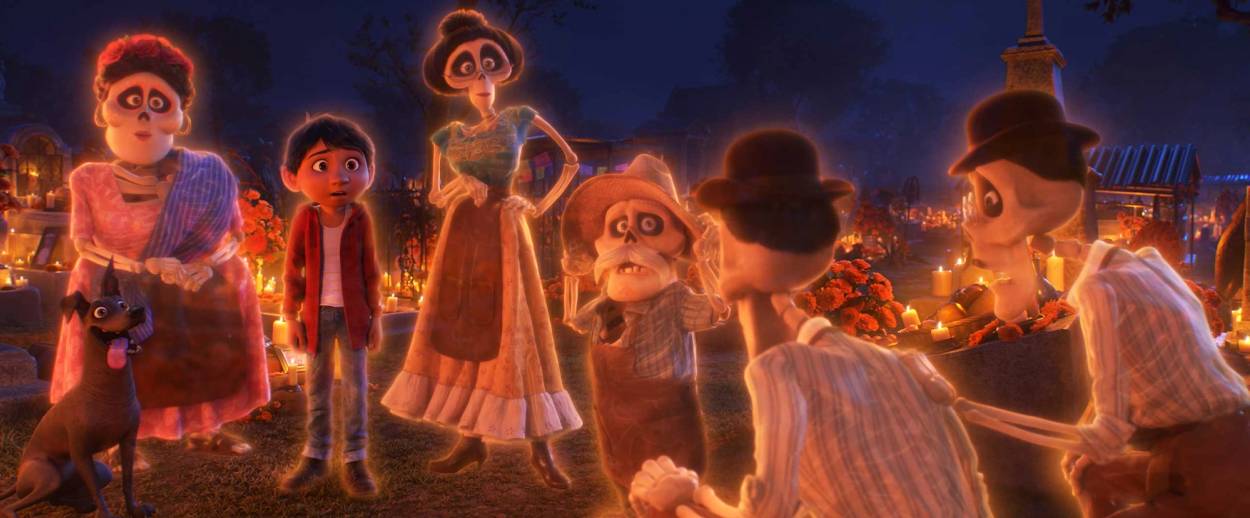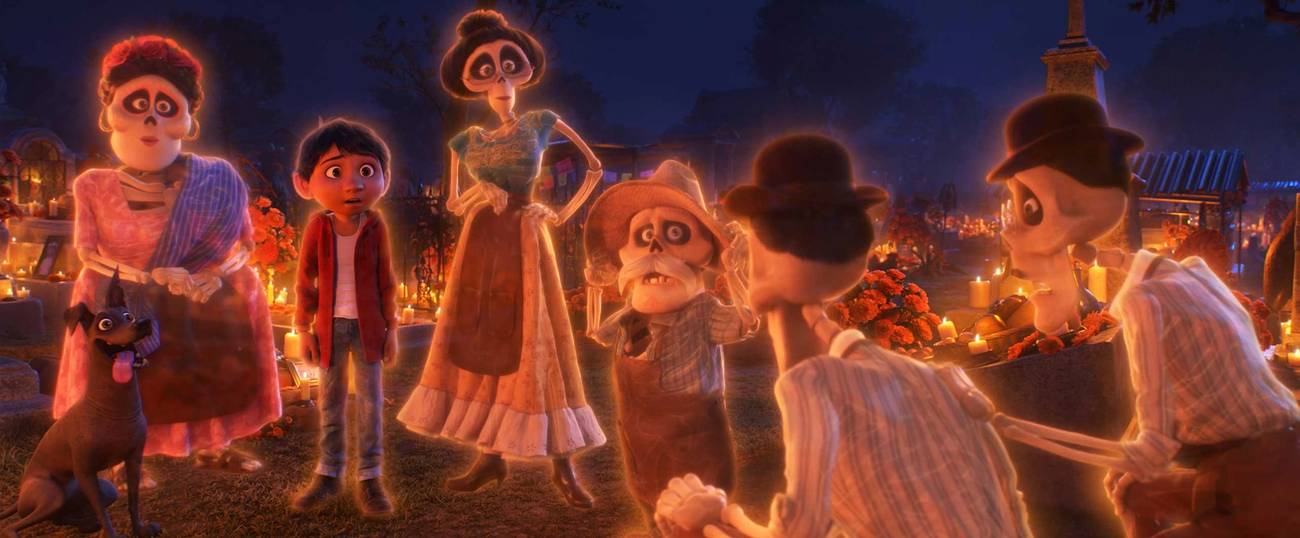What Pixar Movies Can Teach Us About Death and Loss
Coco offers a grown-up depiction of mourning




No matter how often Disney movies begin with a dead mother, they rarely dwell on grief. Pixar movies, on the other hand, have always trafficked in melancholy. They often explore the many facets of loss. They’re funny-sorrowful, melodies in a minor key, tonally Jewish. And this season’s installment is the most mournfully engaging yet.
Just look at the dolorous history of Pixar films: The Toy Story trilogy is about how we humans can never truly know those we love; it ponders the losses we incur simply by growing up. Finding Nemo and Finding Dory look at parents’ fears of losing a child, and concerns about raising a child with a disability. Ratatouille is about all the Proustian associations we have with food—how transporting a taste can be, how tied into golden-toned, long-in-the-past memories. Brave is about mothers and daughters and the necessary pain of growing apart. Inside Out is about coming to accept our own inevitable feelings of depression and anxiety. WALL-E is about isolation and yearning for companionship. Up begins with a perfect, heartbreaking 10-minute aria to romantic love, aging, and the inevitable end to the happiest marriage: death.
Disney generally touches on death and quickly moves on to adventure. But its own most successful film luxuriates in loss: 1994’s The Lion King. Not only does Simba lose his father, he finds the body, curls up with the corpse, and believes himself responsible for Mufasa’s death. This is not a fleeting moment of sorrow; Simba’s loss and guilt fuel his adult mission to return from exile and save his land and pride. I don’t think it’s an accident that audiences adored the film above others; it felt emotionally real in a way few other Disney films had.
In 2006, Disney bought Pixar, and successful Disney films started feeling more like Pixar films: quirkier, psychologically complex, relationship-focused … and again, interested in exploring grief. In 2013, the megahit Frozen explored the relationship between two sisters; the movie (which is infinitely more innovative than most critics gave it credit for) is largely about Elsa’s constant awareness of her own power to destroy. Her self-loathing infuses the film with sadness and loneliness. In 2014’s Big Hero Six, the main character Hiro loses his college-age brother Tadashi in an explosion. Nearly catatonic with sorrow, Hiro inadvertently activates one of his brother’s inventions, a cuddly, marshmallow-y, glowy robot whose purpose is to comfort people.
The emotional high point in last year’s Disney film Moana also involved death. Moana’s fearful parents try to shield her from the wider world, but her grandmother Tala secretly encourages her to explore. Shortly before her death, Tala gives her granddaughter the tools she’ll need not only to become a self-sufficient adult but also to save the family’s endangered Polynesian island. At a crucial moment of loss and betrayal, Tala’s spirit appears to Moana and inspires her to complete her hero’s journey by herself. Moana appeases a vengeful god, heals her island, and teaches her people to be brave, too. As she sails into the future, she’s accompanied by her grandmother’s adventurous spirit in the form of a manta ray. This is less cheesy than it sounds, thanks to a lot of humor, Lin-Manuel Miranda’s sly songs, and the movie’s hypnotic, gorgeously animated waves.
But Coco, this season’s Pixar entry, is not only permeated with the awareness of death, it’s actually about death. Without death, there would be no movie. It’s a must-see, whether you have children or not.
Coco is the story of a little boy named Miguel, from a family of shoemakers, who wants to be a mariachi. But his family forbids it. Many years earlier, Miguel’s great-great-grandfather had abandoned his family to become a singer-songwriter … and when Miguel’s abuelita, now the scion of the family, finds her grandson’s guitar, she smashes it. Miguel, furious, does something foolhardy and finds himself in the Land of the Dead. While there, he’s determined to find his guitar-strumming ancestor, prove his musical chops, and make it back to the land of the living before the end of Día de los Muertos. (It’s a lot.) Meanwhile, the dead have the opportunity to visit the land of the living for this one day only—if anyone left there remembers them and can tell stories about them.
Visually, it’s the most sumptuous animated movie in years—full of the fluorescent colors of Guanajuato, sugar skulls and alebrijes (spirit animals depicted as carved and painted wooden figures), fluttering marigold petals and papel picado banners. Everyone in the Land of the Dead except Miguel is an expressive spooky-cute skeleton, and the longer Miguel stays, the more his human flesh fades. We see his fingers become transparent X-rays, the bones gleaming through shadow-y substance, and over the course of the night, the rest of his body starts turning. It’s unnerving and distressing, but somehow not terrifying.
The plot involves ofrendas—altars on which family members pay tribute to relatives who’ve passed away. The conceit is that if someone’s picture isn’t on an ofrenda, that person can never return. Miguel meets someone who desperately wants to see his still-living family … but that will only be possible if Miguel places his photo on the altar before the last person who remembers him dies.
This movie is suffused with Mexican culture in specific, respectful ways. Longtime Pixar vet Adrian Molina, who is Mexican-American, co-wrote and co-directed the film; the production team consulted with Latino cultural organizations and community leaders throughout the film’s creation and spent time off and on living with families in Oaxaca and Guanajuato for verisimilitude.
But the film’s attitudes toward death resonate with me as a non-Latina Jew. The importance of remembering the dead and the use of storytelling as a strategy for coping with loss and pain seem awfully familiar. So does the notion of death being both finite and infinite. Sitting in the theater, I was reminded of the Yehuda Amichai poem “Near the Wall of a House,” which concludes: “Love is not the last room: There are others/after it, the whole length of the corridor/that has no end.” (I also flashed back to another film about a doctrinaire parent refusing to accept a child who wants to be a performer—thankfully, Coco opted not to do blackface.)
A song from the film, by the writer and lyricist behind Frozen and Avenue Q, expresses Coco’s spirit:
Keep our love alive, I’ll never fade away
Remember me
For soon I will be gone
Remember me
And let the love we have live on
And know that I’m with you the only way that I can be
So until you’re in my arms again, remember me.
Mostly I thought about how modern American Jewish parents could learn a lot from Coco about talking to children about death. I’ve written of my dismay about the practice of rushing children out of the room during the Yizkor service on Yom Kippur. Trying (impossibly) to shield children from death conveys to them that death is something shameful. Coco faces death head-on in its sad, unfair glory, and presents it as an everyday matter, associated not only with loss but also with happy memories and laughter. Unlike Disney films of yore, death isn’t presented sadistically or manipulatively, as the prompt for the hero’s growth (looking at you, Bambi). It’s holistic. But it’s still not entirely accessible or twee, which is as it should be. Coco retains a slightly sinister, mysterious, eerie feeling throughout.
It also clearly shows the wrongness of trying to protect children from too much feeling—too much sorrow, too much risk. Living fully means remembering, even when it’s painful. Consider “We Remember Them,” the poem by Rabbi Jack Riemer and Rabbi Sylvan Kamens in many High Holiday machzorim. It begins, “In the rising of the sun and in its going down/we remember them,” and concludes, “So long as we live, they too shall live, for they are now a part of us/as we remember them.”
As the film ended, I could hear sobbing all around me. All the weepers were grownups. Of course. We understand death and loss infinitely better than kids do. Kids enjoy Miguel’s adventure, the funny dog, the clacking bones, the idea of justice being served and the fatuous villain getting his comeuppance. But adults watch and feel catharsis. We find ourselves brimming with memories of beloved relatives no longer with us and wistful thoughts about them not being truly gone.
***
Like this article? Sign up for our Daily Digest to get Tablet Magazine’s new content in your inbox each morning.
Marjorie Ingall is a former columnist for Tablet, the author of Mamaleh Knows Best, and a frequent contributor to the New York Times Book Review.